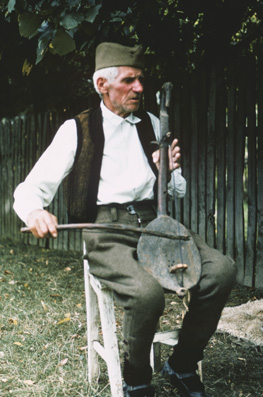Background on Joel Martin Halpern

Photo by Joel Halpern
The sociocultural anthropologist Joel Martin Halpern conducted ethnographic research in regions ranging from the Alaskan arctic to Laos and Lapland, but he is best known for his studies of the effects of modernization in the Balkans. Born in New York City on April 8, 1929, the son of Carl and Nettie, Halpern majored in History as an undergraduate at the University of Michigan. Before his graduation in 1950, he published his first academic works: a series of papers on geology encountered during summers spent in the Alaskan arctic and in northern Canada. Together with his then wife, the linguist and medical anthropologist Barbara Kerewsky-Halpern (she later earned her Ph. D. in anthropology and lingusitics as UMass, Amherst [see Related Items]), Halpern left New York in June 1953 to begin fieldwork, embarking on what would become more than six decades of research in the former Yugoslavia.
For his doctoral work, Halpern undertook a community study of Orasac, a village in the Sumadija district of central Serbia that in 1804 had been the site of the first Serbian uprising against Turkish rule. Like many Serbian villages during the Communist period, Orasac was beginning to experience the shift from an agricultural base of production to industrial employment. Halpern's dissertation, Social and cultural change in a Serbian village (1956) became the basis for his first book, A Serbian Village (N.Y.: Columbia Univ., 1958. revised edition, 1967). Together, the Halperns published a book, A Serbian Village in Historical Perspective (Holt, Rinehart and Winston, 1972. revised edition Waveland Press, 1986)
After completing his degree, Halpern accepted a position as Junior Foreign Service Officer (Foreign Service Reserve) with the Community Development Division of the U.S. International Cooperation Administration (USOM), and embarked on a new field area. Stationed in Laos from January 1957 until January 1958, he became one of the first American anthropologists to work in former French Indo-China, focusing on Lao elites, among other topics. He returned to Laos in 1959 with support of the Rand Corporation, and in 1969, with the support of the Southeast Asia Development Advisory Group. This work resulted in the publication of several volumes in Yale University's Southeast Asia series including: Government, politics, and social structure in Laos: a study of tradition and innovation (New Haven: Yale Univ., 1964), and Economy and society of Laos (New Haven: Yale Univ., 1964). His work for the Rand Corporation in 1959 resulted in The Lao elite: a study of tradition and innovation (Santa Monica, Calif.: Rand Corp., 1964). Halpern's first published volume on Laos was Aspects of village life and culture change in Laos (N.Y.: Council on Economic and Cultural Affairs, 1958). His 22 volumes of Laos Project Papers remain available more than 40 years after they were first issued in the 1960s. His book, The changing village community (Englewood Cliffs, N.J., 1967) drew upon his broad experience in cultural change in village societies.
Following appointments at UCLA (1958-1963) and Brandeis (1963-1965), and as a fellow of the Russian Research Center at Harvard (1965-1967), Halpern joined the faculty at UMass Amherst in 1967, earning promotion to full professor two years later. A prolific writer, Halpern continued research in both Yugoslavia and Laos for many years. He served as a member of the Mekong Seminar of the Southeast Asia Development Advisory Group (SEADAG) of the Asia Society between 1966 and 1970, studying the impact of dams on the Mekong River. In addition to time spent at the University of Graz, Austria following his retirement, he has held visiting professorships at several universities in Europe including the Arnold Bergstrasser Institute of the Albert-Ludwigs-Universitat, Freiburg, Germany (1970-1971). Later in his career, he branched out to study southeast Asian immigrant populations in New England. Halpern co-authored a book with his colleague Lucy Nguyen, then of the United Asia Learning Research Center at UMass, called Far east comes near. The book drew on their joint experience of teaching students of Southeast Asian origin at UMass. Halpern's interest in the history of anthropology was manifest in a special interest in the Polish ethnographer, Josef Obrebski. Halpern negotiated the placement of his papers at the UMass Archives, where they have been of interest to Polish scholars. The papers have been used as a basis not only for the Halperns' book The changing peasantry of Eastern Europe (Schenkman Publishing, 1976), but also for publications about Obrebski that have appeared in Polish. Halpern retired in 1992 and continues to reside in Amherst.
Much of Halpern's research centered on the former Yugoslavia including specific work in the now independent countries of Serbia, Macedonia, Croatia, Bosnia and Slovenia. Besides the Eskimo, including the Inuit of Canada, and Hmong, he has worked with a variety of ethnic groups in the United States including Jewish communities in Western Massachusetts, Southeast Asians and South Slavs in North America. His research has been supported by the National Science Foundation, the National Institutes of Health, the National Endowment for the Humanities, the National Academy of Sciences and the Department of State Counterpoint Funds program. His books, monographs and articles have been published abroad in French, Croatian, German, Japanese, Macedonian, Serbian, Slovenian, and Spanish. His research has reflected active collaboration with German, Austrian, Inuit, Japanese, Serbian and Slovenian scholars. Halpern made a major donation of Balkan books and documents to UCLA, which was made into a 109 reel microfilm collection that has been made available to other libraries.
Halpern's photographic interests are reflected in three major exhibitions, each represented by a published catalog, on Laos, Bosnia and Obrebski. In addition, with the assistance of the Canadian government he organized a major showing, with a published catalog, of Inuit art and film.

